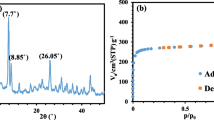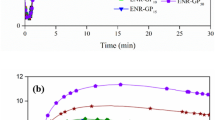Abstract
Herein, the carbon black/graphene oxide/natural rubber composites (CB/GO/NR) with different crosslink networks were prepared through the latex co-precipitation approach. Meanwhile, the type of crosslinks on the crack propagation resistance and fatigue life in different vulcanized systems was investigated. As a result, CB/GO/NR composites dominated by polysulfide in the conventional vulcanization (CV) system exhibited the highest tear strength (71.6 kN/m) and lowest crack growth rate (64.1 nm/cycle), the crosslink network and polysulfide-based crosslink structure in the CV system were the key factors to improve the crack propagation resistance. In addition, the relationship between viscoelasticity and dynamic crack propagation behavior of CB/GO/NR is studied, and the CV system had the lowest loss compliance modulus (J″ = 0.0014 Mpa−1), thus more energy dissipation occurred in the crack propagation region and the crack propagation resistance of CV system was improved. Importantly, this work can provide the guideline for designing the rubber-based composites in the practical engineering applications.
Graphical Abstract










Similar content being viewed by others

References
An D, Cheng S, Zhang Z et al (2019) A polymer-based thermal management material with enhanced thermal conductivity by introducing three-dimensional networks and covalent bond connections. Carbon 155:258–267. https://doi.org/10.1016/j.carbon.2019.08.072
Li F, Li Q, Kimura H et al (2023) Morphology controllable urchin-shaped bimetallic nickel-cobalt oxide/carbon composites with enhanced electromagnetic wave absorption performance. J Mater Sci Technol 48:250–259. https://doi.org/10.1016/j.jmst.2022.12.003
Duan X, Cheng S, Tao R et al (2022) Synergistically enhanced thermal control ability and mechanical properties of natural rubber for tires through a graphene/silica with a dot-face structure. Adv Compos Hybrid Mater 5(2):1145–1157. https://doi.org/10.1007/s42114-022-00453-y
Pan D, Yang G, Abo-Dief HM et al (2022) Vertically aligned silicon carbide nanowires/boron nitride cellulose aerogel networks enhanced thermal conductivity and electromagnetic absorbing of epoxy composites. Nano-Micro Lett 14(1):118. https://doi.org/10.1007/s40820-022-00863-z
Yu J, Xian S, Zhang Z et al (2022) Synergistic piezoelectricity enhanced BaTiO3/polyacrylonitrile elastomer-based highly sensitive pressure sensor for intelligent sensing and posture recognition applications. Nano Res 1–13. https://doi.org/10.1007/s12274-022-5084-x
Fan M, Wu L, Hu Y et al (2021) A highly stretchable natural rubber/buckypaper/natural rubber (NR/N-BP/NR) sandwich strain sensor with ultrahigh sensitivity. Adv Compos Hybrid Mater 4:1039–1047. https://doi.org/10.1007/s42114-021-00298-x
Wu S, Zhang Y, Zhang Y, Gong Y, Hao Z (2022) Preparation and characterization of Kaolinite supported lanthanum-hydroxide and its improvements for natural rubber composites. Appl Clay Sci 216:106342. https://doi.org/10.1016/j.clay.2021.106342
Jiang W, Gu J (2020) Nanocrystalline cellulose isolated from different renewable sources to fabricate natural rubber composites with outstanding mechanical properties. Cellulose 27(10):5801–5813. https://doi.org/10.1007/s10570-020-03209-3
Li S, Wang Y, Xu W, Shi B (2020) Natural Rubber-based elastomer reinforced by chemically modified multiscale leather collagen fibers with excellent toughness. ACS Sustain Chem Eng 8(13):5091–5099. https://doi.org/10.1021/acssuschemeng.9b07078
Li H, Yang L, Weng G, Xing W et al (2015) Toughening rubbers with a hybrid filler network of graphene and carbon nanotubes. J Mater Chem A 44:22385–22392. https://doi.org/10.1039/c5ta05836h
Xu Z, Jerrams S, Guo H, Zhou Y, Jiang L, Gao Y et al (2020) Influence of graphene oxide and carbon nanotubes on the fatigue properties of silica/styrene-butadiene rubber composites under uniaxial and multiaxial cyclic loading. Int J Fatigue 131:105388. https://doi.org/10.1016/j.ijfatigue.2019.105388
Dong B, Liu C, Lu Y, Wu Y (2015) Synergistic effects of carbon nanotubes and carbon black on the fracture and fatigue resistance of natural rubber composites. J Appl Polym Sci 132(25):42075. https://doi.org/10.1002/app.42075
De Pannemaecker A, Fouvry S, Buffiere JY, Brochu M (2018) Modelling the fretting fatigue crack growth: From short crack correction strategies to microstructural approaches. Int J Fatigue 117:75–89. https://doi.org/10.1016/j.ijfatigue.2018.07.034
Yin L, Luo Z, Zhong J, Yang B, Ji Y (2020) Behaviour and mechanism of fatigue crack growth in aramid-fibre-reinforced styrene–butadiene rubber composites. Int J Fatigue 134:105502. https://doi.org/10.1016/j.ijfatigue.2020.105502
Goegelein C, Beelen H, Duin MVJSM (2017) Morphological explanation of high tear resistance of EPDM/NR rubber blends. Soft Matter 13:4241–4251. https://doi.org/10.1039/c7sm00264e
Zhao B, Liang L, Bai Z et al (2021) Poly (vinylidene fluoride)/Cu@ Ni anchored reduced-graphene oxide composite films with folding movement to boost microwave absorption properties. ES Energ Environ 14:79–86. https://doi.org/10.30919/esee8c488
Tiwari N, Kulkarni S (2022) Impact of current collector on supercapacitive performance of hydrothermally reduced graphene oxide electrode. ES Energ Environ 15:67–75. https://doi.org/10.30919/esee8c614
Zhu Q, Zhao Y, Miao B et al (2022) Hydrothermally synthesized ZnO-RGO-PPy for water-borne epoxy nanocomposite coating with anticorrosive reinforcement. Prog Org. Coa 172:107153. https://doi.org/10.1016/j.porgcoat.2022.107153
Zhao Z, Zhao R, Bai P et al (2021) AZ91 alloy nanocomposites reinforced with Mg-coated graphene: phases distribution, interfacial microstructure, and property analysis. J Alloy Compd 902:163484. https://doi.org/10.1016/j.jallcom.2021.163484
Kakade PM, Kachere AR, Rondiya SR et al (2021) Graphene oxide assisted synthesis of magnesium oxide nanorods. ES Mater Manuf 12(2):63–71. https://doi.org/10.30919/esmm5f1044
Hui Y, Xie W, Gu H (2021) Reduced graphene oxide/nanocellulose/amino-multiwalled carbon nanotubes nanocomposite aerogel for excellent oil adsorption. ES Food Agrofor 5:38–44. https://doi.org/10.30919/esfaf531
Chu L, Kan M, Jerrams S, Zhang R, Xu Z, Liu L et al (2022) Constructing chemical interface layers by using ionic liquid in graphene oxide/rubber composites to achieve high-wear resistance in environmental-friendly green tires. ACS Appl Mater Interface 14(4):5995–6004. https://doi.org/10.1021/acsami.1c21605
Liu C, Dong B, Zheng Q et al (2015) Influence of strain amplification near crack tip on the fracture resistance of carbon black–filled SBR. Rub Chem Technol 88(2):276–288. https://doi.org/10.5254/rct.15.85956
Xue C, Gao H, Hu G (2020) Viscoelastic and fatigue properties of graphene and carbon black hybrid structure filled natural rubber composites under alternating loading. Constr Build Mater 265:120299. https://doi.org/10.1016/j.conbuildmat.2020.120299
Cheng S, Duan X, Zhang Z, An D, Zhao G, Liu Y (2021) Preparation of a natural rubber with high thermal conductivity, low heat generation and strong interfacial interaction by using NS-modified graphene oxide. J Mater Sci 56(5):4034–4050. https://doi.org/10.1007/s10853-020-05503-8
Guo H, Jerrams S, Xu Z, Zhou Y, Jiang L, Zhang L et al (2020) Enhanced fatigue and durability of carbon black/natural rubber composites reinforced with graphene oxide and carbon nanotubes. Eng Fract Mech 223:106764. https://doi.org/10.1016/j.engfracmech.2019.106764
Chun H, Gent AN (1996) Strength of sulfur-linked elastomers. Rub Chem Technol 69(4):577–590. https://doi.org/10.5254/1.3538385
Zaimova D, Bayraktar E, Miskioglu I (2016) Design and manufacturing of new elastomeric composites: mechanical properties, chemical and physical analysis. Compos B Eng 105:203–210. https://doi.org/10.1016/j.compositesb.2016.05.061
Rabiei S, Shojaei A (2016) Vulcanization kinetics and reversion behavior of natural rubber/styrene-butadiene rubber blend filled with nanodiamond – the role of sulfur curing system. Eur Polym J 81:98–113. https://doi.org/10.1016/j.eurpolymj.2016.05.021
Hernández M, Valentín JL, López-Manchado MA (2015) Influence of the vulcanization system on the dynamics and structure of natural rubber: comparative study by means of broadband dielectric spectroscopy and solid-state NMR spectroscopy. Eur Polym J 68:90–103. https://doi.org/10.1016/j.eurpolymj.2015.04.021
Mansilla MA, Marzocca AJ, Macchi C (2017) Natural rubber/styrene-butadiene rubber blends prepared by solution mixing: influence of vulcanization temperature using a Semi-EV sulfur curing system on the microstructural properties. Polym Test 63:150–157. https://doi.org/10.1016/j.polymertesting.2017.07.025
Honorato LR, Visconte LLY, Nunes RCR (2022) Effect of different cure systems on natural rubber/nanocellulose nanocomposites in rheological, physical-mechanical, aging, and mechanical properties. J Elastom 54(5):676–692. https://doi.org/10.1177/00952443221077438
Wang D, Tang Z, Liu Y et al (2020) Crosslinking diene rubbers by using an inverse vulcanised co-polymer. Green Chem 22(21):7337–7342. https://doi.org/10.1039/d0gc02660c
Gumede JI, Hlangothi BG, Mabuto B et al (2022) Devulcanization of natural rubber/styrene-butadiene rubber unfilled blend in supercritical carbon dioxide using Tulbaghia violacea crude extract. J Clean Prod 362:132478. https://doi.org/10.1016/j.jclepro.2022.132478
Chen L, Jia Z, Tang Y, Wu L, Luo Y (2017) Novel functional silica nanoparticles for rubber vulcanization and reinforcement. Compos Sci Technol 144:11–17. https://doi.org/10.1016/j.compscitech.2016.11.005
Yasin S, Hussain M, Zheng Q, Song Y (2021) Effects of ionic liquid on cellulosic nanofiller filled natural rubber bionanocomposites. J Colloid Interf Sci 591:409–417. https://doi.org/10.1016/j.jcis.2021.02.029
Marzocca AJ (2007) Evaluation of the polymer–solvent interaction parameter χ for the system cured styrene butadiene rubber and toluene. Eur Polym J 43(6):2682–2689. https://doi.org/10.1016/j.eurpolymj.2007.02.034
Kaang S, Jin YW, Huh Y, Lee WJ, Im WB (2006) A test method to measure fatigue crack growth rate ofrubbery materials. Polym Test 25(3):347–352. https://doi.org/10.1016/j.polymertesting.2005.12.005
Amstutz C, Burgi M, Jousset P (2018) Characterisation and FE simulation of polyurethane elastic bonded joints under multiaxial loading conditions. Int J Adhes Adhes 83:103–115. https://doi.org/10.1016/j.ijadhadh.2018.02.029
Zhang R, Yan T, Lechner B-D, Schröter K, Liang Y, Li B et al (2013) Heterogeneity, segmental and hydrogen bond dynamics, and aging of supramolecular self-healing rubber. Macromolecules 46(5):1841–1850. https://doi.org/10.1021/ma400019m
Singh K, Blümich B (2018) Compact low-field NMR spectroscopy and chemometrics: a tool box for quality control of raw rubber. Polymer 141:154–165. https://doi.org/10.1016/j.polymer.2018.02.057
da Silva LP, Luetkmeyer L, Furtado CRG, Bruno Tavares MI, Pacheco EBAV (2009) Characterization of pp/regenerated tire-rubber blends using proton spin-lattice relaxation time. Polym Test 28(1):53–56. https://doi.org/10.1016/j.polymertesting.2008.10.002
Tang Z, Wu X, Guo B, Zhang L, Jia D (2012) Preparation of butadiene–styrene–vinyl pyridine rubber– graphene oxide hybrids through co-coagulation process and in situ interface tailoring. J Mater Chem A 22(15):7492–7501. https://doi.org/10.1039/c2jm00084a
Chen L, Wu L, Song L, Xia Z, Lin Y, Chen W et al (2020) The recovery of nano-sized carbon black filler structure and its contribution to stress recovery in rubber nanocomposites. Nanoscale 12(48):24527–24542. https://doi.org/10.1039/d0nr06003h
Greensmith HW (1960) Rupture of rubber. VIII. Comparisons of tear and tensile rupture measurements. J Appl Polym Sci 3(8):183–193. https://doi.org/10.1002/app.1960.070030807
Hernández M, Grande AM, Dierkes W, Bijleveld J, van der Zwaag S, García SJ (2016) Turning vulcanized natural rubber into a self-healing polymer: effect of the disulfide/polysulfide ratio. ACS Sustain Chem Eng 4(10):5776–5784. https://doi.org/10.1021/acssuschemeng.6b01760
Persson BNJ, Brener EA (2005) Crack propagation in viscoelastic solids. Phys Rev E 71(3):036123. https://doi.org/10.1103/PhysRevE.71.036123
Han Q, Zhang L, Wu YJRA (2019) Relationship between dynamic fatigue crack propagation properties and viscoelasticity of natural rubber/silicone rubber composites. RSC Adv 9(51):29813–29820. https://doi.org/10.1039/c9ra05833h
Morishita Y, Tsunoda K, Urayama KJPRE (2016) Velocity transition in the crack growth dynamics of filled elastomers: contributions of nonlinear viscoelasticity. Phys Rev E 93(4):043001. https://doi.org/10.1103/PhysRevE.93.043001
Rooj S, Das A, Morozov IA, Stöckelhuber KW, Stocek R, Heinrich G (2013) Influence of “expanded clay” on the microstructure and fatigue crack growth behavior of carbon black filled NR composites. Compos Sci Technol 76:61–68. https://doi.org/10.1016/j.compscitech.2012.12.020
Liu J, Lu Y-L, Tian M, Li F, Shen J, Gao Y et al (2013) The interesting influence of nanosprings on the viscoelasticity of elastomeric polymer materials: simulation and experiment. Adv Funct Mater 23(9):1156–1163. https://doi.org/10.1002/adfm.201201438
Gudimetla MR, Doghri I (2017) A finite strain thermodynamically-based constitutive framework coupling viscoelasticity and viscoplasticity with application to glassy polymers. Int J Plast 98:197–216. https://doi.org/10.1016/j.ijplas.2017.08.001
Weng G, Yao H, Chang A, Fu K, Liu Y, Chen ZJRA (2014) Crack growth mechanism of natural rubber under fatigue loading studied by a real-time crack tip morphology monitoring method. J Am Chem Soc 4(83):43942–43950. https://doi.org/10.1039/c4ra06518b
Araujo-Morera J, López-Manchado MA, Verdejo R, Hernández Santana M (2022) Unravelling the effect of healing conditions and vulcanizing additives on the healing performance of rubber networks. Polymer 238:124399. https://doi.org/10.1016/j.polymer.2021.124399
Funding
The authors received financial support from the Natural Science Foundation of Shanxi Province (Grant No. 20210302124430), the Shanxi Provincial Science and Technology Major Project (Grant No. 20181101010) and Graduate Education Innovation Project Approval Number of Shanxi Province (2022Y613).
Author information
Authors and Affiliations
Contributions
Zhiwei Li: conceptualization, formal analysis, writing–original draft. Dong An: formal analysis. Rizheng He: investigation. Zhijian Sun: investigation. Jiaxiong Li: investigation. Zhiyi Zhang: formal analysis. Yaqing Liu: supervision. Chingping Wong: writing–review and editing.
Corresponding authors
Ethics declarations
Competing interests
The authors declare no competing interests.
Additional information
Publisher's Note
Springer Nature remains neutral with regard to jurisdictional claims in published maps and institutional affiliations.
Supplementary Information
Below is the link to the electronic supplementary material.
Rights and permissions
Springer Nature or its licensor (e.g. a society or other partner) holds exclusive rights to this article under a publishing agreement with the author(s) or other rightsholder(s); author self-archiving of the accepted manuscript version of this article is solely governed by the terms of such publishing agreement and applicable law.
About this article
Cite this article
Li, Z., An, D., He, R. et al. The design of crosslinks in different vulcanized systems to improve crack growth resistance for carbon black/graphene oxide/natural rubber composites. Adv Compos Hybrid Mater 6, 82 (2023). https://doi.org/10.1007/s42114-023-00662-z
Received:
Revised:
Accepted:
Published:
DOI: https://doi.org/10.1007/s42114-023-00662-z



